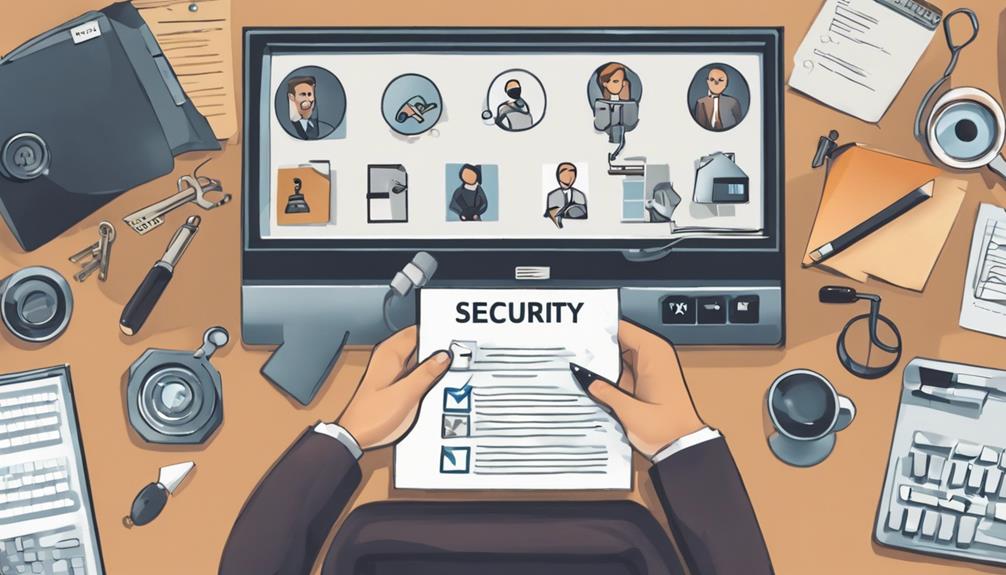You might be surprised to learn that nearly 60% of small businesses experience a significant security incident within six months of an audit. A security audit can be a game-changer for your business by pinpointing vulnerabilities and ensuring you're compliant with necessary standards. However, most audits reveal common issues that could put your operations at risk, like outdated software or inadequate employee training. Understanding these findings could be essential for your business's safety and success, so let's explore how you can turn potential weaknesses into strengths.
Key Takeaways
- Security audits identify vulnerabilities, helping businesses proactively address weaknesses and enhance overall safety measures.
- Regular audits ensure compliance with standards, reducing risks and building stakeholder trust in the organization's security protocols.
- Common issues found during audits include outdated software, weak password practices, and insufficient staff training on security protocols.
- Effective access control measures and robust network security are crucial to prevent unauthorized access and protect sensitive data.
- Physical security assessments, including surveillance evaluations, help identify blind spots and improve monitoring capabilities for a comprehensive security approach.
Importance of Security Audits

Recognizing the critical nature of security audits is essential for any business aiming to safeguard its assets and reputation. Regular audits not only identify vulnerabilities but also align your organization with compliance requirements, mitigating risks that could lead to severe financial and legal consequences. By prioritizing security audits, you assert your commitment to maintaining a robust security posture, which can enhance stakeholder confidence and deter potential breaches. Additionally, a well-structured audit process empowers you to allocate resources effectively, addressing gaps in your security framework. Implementing tailored security solutions, such as biometric entry systems, can further enhance your business's overall safety and protection. Ultimately, understanding and implementing security audits positions your business as a leader in risk management, safeguarding your brand and fostering trust in an increasingly complex environment.
Benefits of Regular Audits
In the domain of business security, regular audits serve as an essential tool for enhancing operational resilience. By establishing a consistent audit frequency, you create a robust framework for ongoing risk assessment. This proactive approach not only identifies vulnerabilities but also empowers you to address potential threats before they escalate. Regular audits provide critical insights into compliance with industry standards and internal policies, ensuring that your business remains aligned with best practices. Additionally, they foster a culture of accountability and continuous improvement among your staff. Ultimately, embracing regular audits enhances your capacity to mitigate risks, fortify your defenses, and maintain stakeholder trust. In a competitive landscape, this strategic commitment sets you apart as a leader in security excellence.
Understanding Business Vulnerabilities

A thorough understanding of business vulnerabilities is essential for safeguarding your organization against potential threats. By conducting an extensive risk assessment, you can identify weaknesses that could lead to security breaches. Implementing effective vulnerability management strategies enables you to prioritize these risks and allocate resources accordingly.
| Vulnerability Type | Impact |
|---|---|
| Physical Security | Theft, Damage |
| Cybersecurity | Data Breaches, Hacks |
| Human Factors | Insider Threats, Errors |
Recognizing these vulnerabilities is vital for strengthening your defenses. It empowers you to make informed decisions that enhance your security posture. Addressing vulnerabilities proactively not only protects your assets but also fosters trust among clients and stakeholders, establishing your organization as a leader in security.
Common Security Issues Identified
When evaluating your business's security posture, you'll often encounter issues like outdated software and weak password practices. These vulnerabilities can greatly increase the risk of breaches and data loss. It's essential to address these common security pitfalls to enhance your overall safety.
Outdated Software Vulnerabilities
Because outdated software can serve as a gateway for cybercriminals, businesses must prioritize regular updates to mitigate vulnerabilities. Conducting a thorough vulnerability assessment reveals which applications require immediate software patching. These assessments not only identify outdated programs but also highlight specific vulnerabilities, enabling you to take decisive action. Failing to address these flaws can lead to severe data breaches, financial loss, and reputational damage. Regular patching schedules should be non-negotiable, ensuring your systems remain fortified against emerging threats. Additionally, consider implementing automated updates to streamline the process and reduce human error. By treating software maintenance as a strategic imperative, you empower your business to uphold its security posture and safeguard sensitive information against evolving cyber risks. Remember, implementing recommendations from expert locksmiths can further enhance your business security measures.
Weak Password Practices
Weak password practices remain one of the most prevalent security issues that businesses face today. Many organizations fail to enforce strong password complexity, leaving their systems vulnerable to unauthorized access. Weak passwords, often predictable or reused across multiple accounts, create an easy target for cybercriminals.
To combat this threat, you must prioritize user training, educating employees about the importance of crafting robust passwords and recognizing potential phishing attempts. Implementing mandatory password policies that require a mix of letters, numbers, and symbols can greatly enhance your security posture. Additionally, consider employing multi-factor authentication as a supplementary layer of defense. By addressing weak password practices, you're not just protecting your assets; you're fortifying your organization's reputation and operational integrity.
Physical Security Concerns

When evaluating physical security concerns, you need to assess access control measures to guarantee only authorized personnel can enter sensitive areas. Additionally, a thorough surveillance system evaluation is essential for monitoring activities and deterring potential threats. Both components play an important role in safeguarding your business assets and maintaining a secure environment.
Access Control Measures
Effective access control measures are essential for safeguarding your business against unauthorized entry and potential security breaches. By implementing robust user access protocols and effective role management, you guarantee that only authorized personnel can access sensitive areas and information. Here's a breakdown of common access control measures:
| Measure | Description |
|---|---|
| Key Card Systems | Electronic cards granting access |
| Biometric Scanners | Fingerprint or facial recognition |
| Visitor Logs | Tracking and monitoring guests |
Assessing these measures during a security audit can reveal weaknesses in your current system. Identify areas for improvement and enforce stringent controls to fortify your premises against threats. Prioritize access control to maintain integrity and confidentiality within your organization.
Surveillance System Assessment
A thorough assessment of your surveillance system is essential, as it directly impacts your business's physical security posture. You need to evaluate the surveillance technology in place, ensuring it aligns with your security objectives. Consider the resolution and placement of cameras, as well as the range they cover. Analyze the monitoring effectiveness—are your systems capturing critical incidents, or are blind spots compromising security? Additionally, assess the integration of your surveillance with other security measures. Are alarms triggered when unauthorized access occurs? By identifying weaknesses in your surveillance setup, you can enhance your overall security strategy, preventing potential breaches and ensuring a safer environment for your operations. Remember, a robust surveillance system is a cornerstone of effective physical security management.
Cybersecurity Weaknesses
Numerous businesses underestimate the significance of identifying their cybersecurity weaknesses, putting themselves at risk of severe data breaches. By recognizing these vulnerabilities, you can fortify your data protection and enhance your incident response strategies. Here's a breakdown of common cybersecurity weaknesses:
| Weakness Type | Impact Level |
|---|---|
| Outdated Software | High |
| Weak Password Policies | Medium |
| Insufficient Training | High |
| Lack of Encryption | Severe |
| Poor Network Security | High |
Addressing these weaknesses not only safeguards your assets but also empowers you to maintain operational integrity. A security audit shines a light on these critical areas, enabling you to take decisive action and protect your business from potential threats.
Enhancing Security With Low Rate Locksmith

Investing in security measures through a low-rate locksmith can greatly enhance your business's protection against unauthorized access and potential breaches. By leveraging affordable locksmith services, you can implement essential security upgrades that fortify your premises without straining your budget. These professionals provide tailored solutions, from high-quality locks to advanced access control systems, ensuring your security meets the demands of your specific environment. Additionally, a low-rate locksmith can conduct thorough assessments of your current security layout, identifying vulnerabilities that may have been overlooked. This proactive approach not only strengthens your defenses but also empowers you to make informed decisions about future investments in security technology. Ultimately, partnering with a skilled locksmith can be a critical step in safeguarding your business assets and reputation.
Steps to Prepare for an Audit
After reinforcing your security with the help of a low-rate locksmith, it's essential to prepare for an audit that evaluates the effectiveness of those measures. Start by developing an audit checklist tailored to your business's specific needs. This checklist should encompass all security protocols, access controls, and incident response strategies. Businesses often underestimate the importance of a security audit, which can lead to overlooking vital vulnerabilities Understanding the Value of a Security Audit for Businesses. Next, conduct pre-audit training for your staff to guarantee they understand their roles during the audit process. Inform them about potential questions, procedures, and the importance of security compliance. Gather all relevant documentation that supports your security measures, including policies and training records. By systematically preparing in this manner, you empower your organization to present a strong defense against vulnerabilities, fostering a culture of accountability and safety.









